Challenges of Attracting and Retaining Staff in the Healthcare Sector
VerifiedAdded on 2022/11/26
|12
|3491
|155
Essay
AI Summary
This essay delves into the significant challenges the healthcare sector faces in attracting and retaining qualified staff, highlighting the impact of technological advancements, ethical considerations, and the need for skilled professionals. The essay explores the evolution of human resource management, industrial relations, and the importance of human resource planning, work design, talent acquisition, and retention strategies within the healthcare context. It addresses critical issues such as staffing shortages, high turnover rates, and staff burnout, emphasizing the need for improved work systems, employee training and development, and employee well-being. The discussion covers the impact of technology, performance management, and the importance of creating a supportive work environment to enhance employee satisfaction and improve patient care. The essay also references the need for strategic reward management and managing workplace health and safety. The essay highlights the interconnectedness of various factors, including the baby boomer generation's impact on the healthcare workforce, the importance of human resources, and the crucial role of organizational transparency and employee growth opportunities in attracting and retaining talent. The essay concludes by emphasizing the importance of addressing staff burnout, improving performance management systems, and fostering a positive work culture to ensure the long-term success of healthcare organizations.
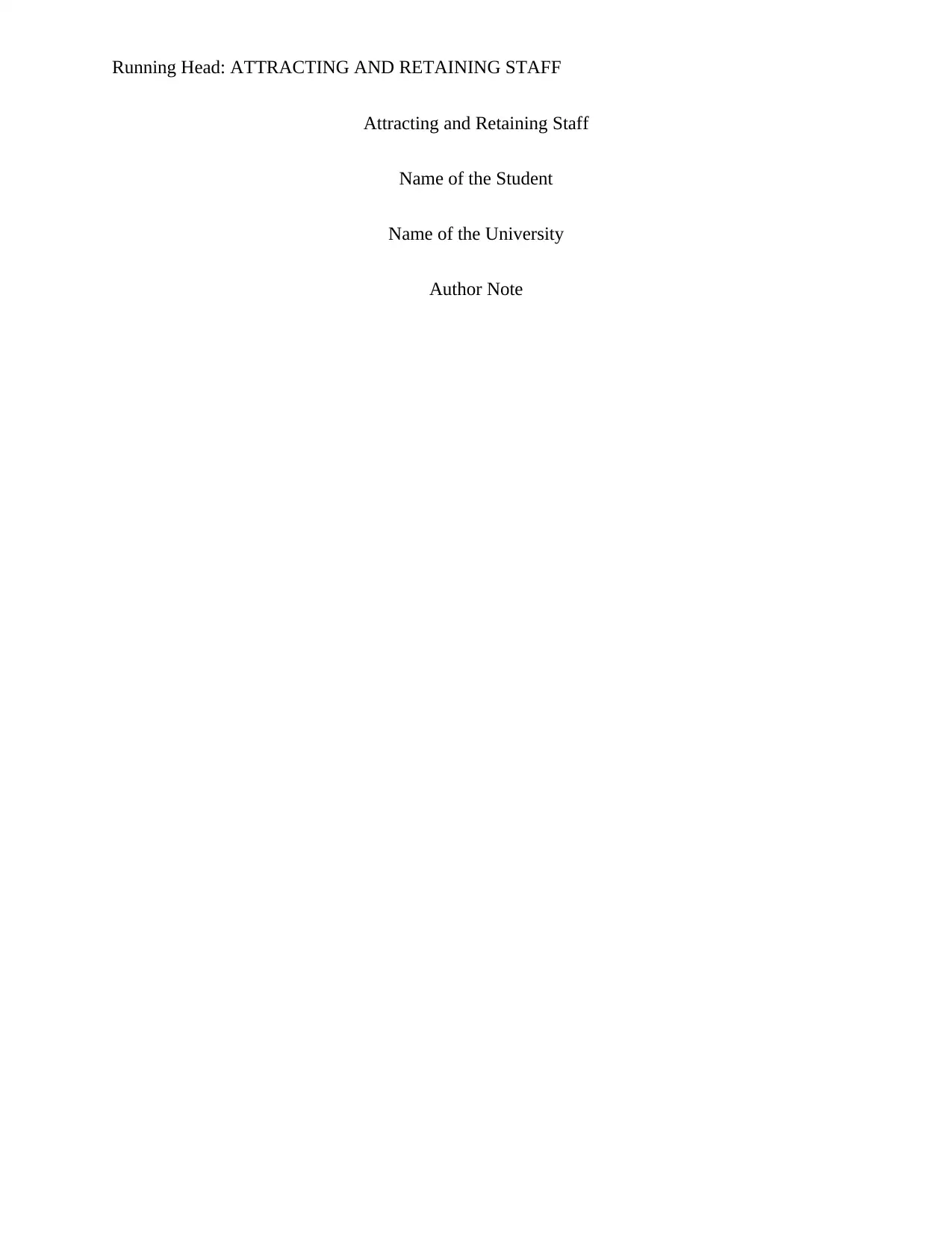
Running Head: ATTRACTING AND RETAINING STAFF
Attracting and Retaining Staff
Name of the Student
Name of the University
Author Note
Attracting and Retaining Staff
Name of the Student
Name of the University
Author Note
Paraphrase This Document
Need a fresh take? Get an instant paraphrase of this document with our AI Paraphraser
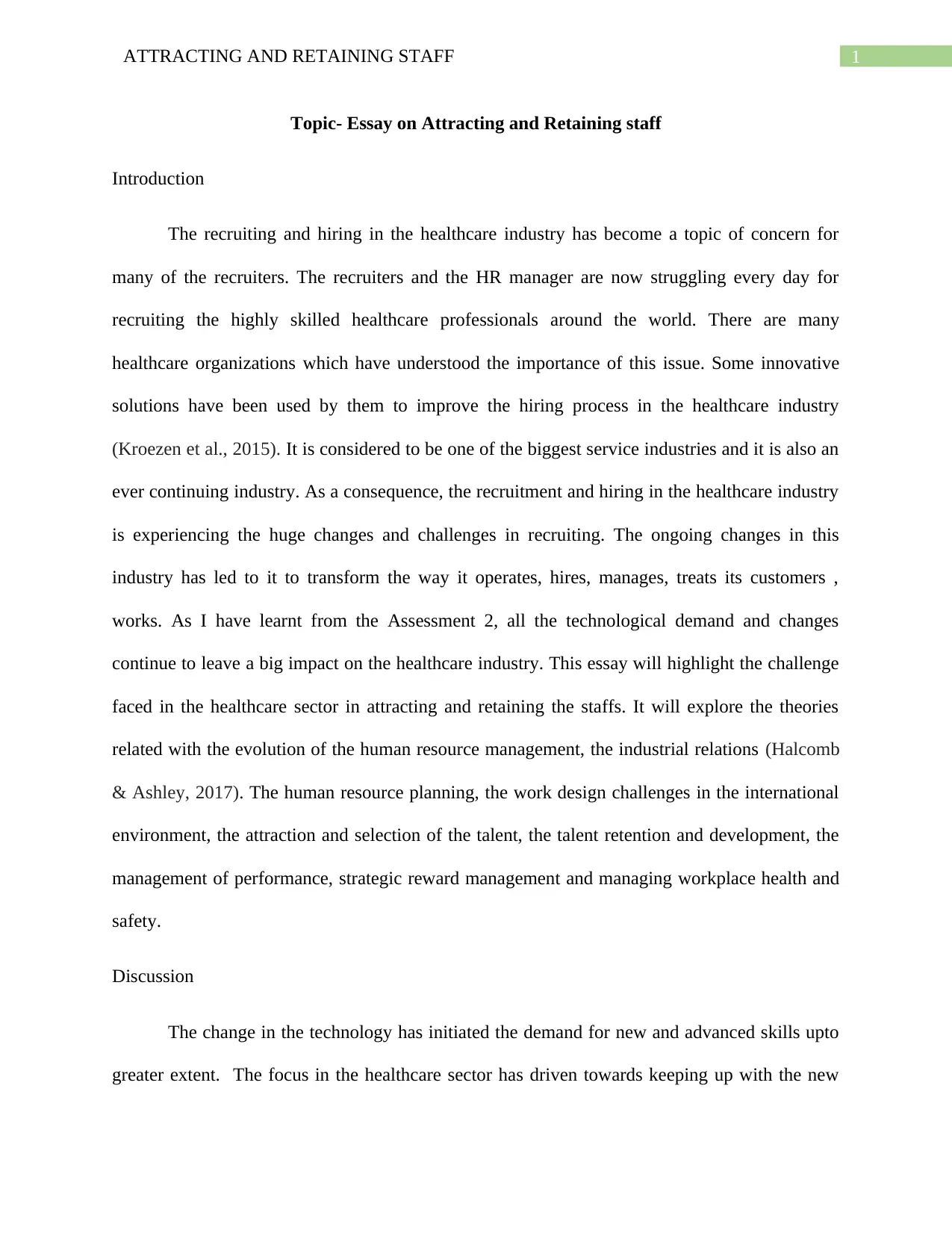
1ATTRACTING AND RETAINING STAFF
Topic- Essay on Attracting and Retaining staff
Introduction
The recruiting and hiring in the healthcare industry has become a topic of concern for
many of the recruiters. The recruiters and the HR manager are now struggling every day for
recruiting the highly skilled healthcare professionals around the world. There are many
healthcare organizations which have understood the importance of this issue. Some innovative
solutions have been used by them to improve the hiring process in the healthcare industry
(Kroezen et al., 2015). It is considered to be one of the biggest service industries and it is also an
ever continuing industry. As a consequence, the recruitment and hiring in the healthcare industry
is experiencing the huge changes and challenges in recruiting. The ongoing changes in this
industry has led to it to transform the way it operates, hires, manages, treats its customers ,
works. As I have learnt from the Assessment 2, all the technological demand and changes
continue to leave a big impact on the healthcare industry. This essay will highlight the challenge
faced in the healthcare sector in attracting and retaining the staffs. It will explore the theories
related with the evolution of the human resource management, the industrial relations (Halcomb
& Ashley, 2017). The human resource planning, the work design challenges in the international
environment, the attraction and selection of the talent, the talent retention and development, the
management of performance, strategic reward management and managing workplace health and
safety.
Discussion
The change in the technology has initiated the demand for new and advanced skills upto
greater extent. The focus in the healthcare sector has driven towards keeping up with the new
Topic- Essay on Attracting and Retaining staff
Introduction
The recruiting and hiring in the healthcare industry has become a topic of concern for
many of the recruiters. The recruiters and the HR manager are now struggling every day for
recruiting the highly skilled healthcare professionals around the world. There are many
healthcare organizations which have understood the importance of this issue. Some innovative
solutions have been used by them to improve the hiring process in the healthcare industry
(Kroezen et al., 2015). It is considered to be one of the biggest service industries and it is also an
ever continuing industry. As a consequence, the recruitment and hiring in the healthcare industry
is experiencing the huge changes and challenges in recruiting. The ongoing changes in this
industry has led to it to transform the way it operates, hires, manages, treats its customers ,
works. As I have learnt from the Assessment 2, all the technological demand and changes
continue to leave a big impact on the healthcare industry. This essay will highlight the challenge
faced in the healthcare sector in attracting and retaining the staffs. It will explore the theories
related with the evolution of the human resource management, the industrial relations (Halcomb
& Ashley, 2017). The human resource planning, the work design challenges in the international
environment, the attraction and selection of the talent, the talent retention and development, the
management of performance, strategic reward management and managing workplace health and
safety.
Discussion
The change in the technology has initiated the demand for new and advanced skills upto
greater extent. The focus in the healthcare sector has driven towards keeping up with the new
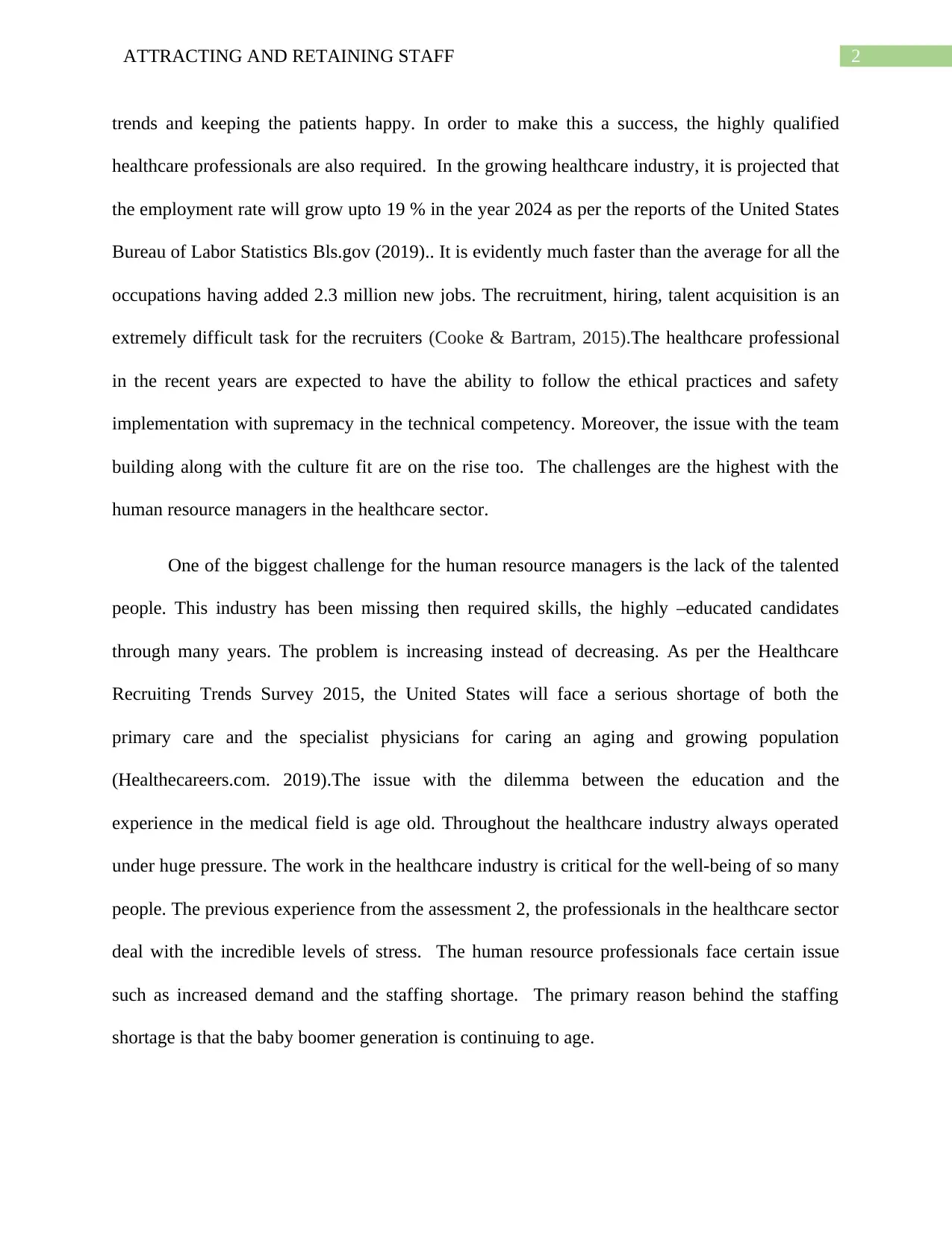
2ATTRACTING AND RETAINING STAFF
trends and keeping the patients happy. In order to make this a success, the highly qualified
healthcare professionals are also required. In the growing healthcare industry, it is projected that
the employment rate will grow upto 19 % in the year 2024 as per the reports of the United States
Bureau of Labor Statistics Bls.gov (2019).. It is evidently much faster than the average for all the
occupations having added 2.3 million new jobs. The recruitment, hiring, talent acquisition is an
extremely difficult task for the recruiters (Cooke & Bartram, 2015).The healthcare professional
in the recent years are expected to have the ability to follow the ethical practices and safety
implementation with supremacy in the technical competency. Moreover, the issue with the team
building along with the culture fit are on the rise too. The challenges are the highest with the
human resource managers in the healthcare sector.
One of the biggest challenge for the human resource managers is the lack of the talented
people. This industry has been missing then required skills, the highly –educated candidates
through many years. The problem is increasing instead of decreasing. As per the Healthcare
Recruiting Trends Survey 2015, the United States will face a serious shortage of both the
primary care and the specialist physicians for caring an aging and growing population
(Healthecareers.com. 2019).The issue with the dilemma between the education and the
experience in the medical field is age old. Throughout the healthcare industry always operated
under huge pressure. The work in the healthcare industry is critical for the well-being of so many
people. The previous experience from the assessment 2, the professionals in the healthcare sector
deal with the incredible levels of stress. The human resource professionals face certain issue
such as increased demand and the staffing shortage. The primary reason behind the staffing
shortage is that the baby boomer generation is continuing to age.
trends and keeping the patients happy. In order to make this a success, the highly qualified
healthcare professionals are also required. In the growing healthcare industry, it is projected that
the employment rate will grow upto 19 % in the year 2024 as per the reports of the United States
Bureau of Labor Statistics Bls.gov (2019).. It is evidently much faster than the average for all the
occupations having added 2.3 million new jobs. The recruitment, hiring, talent acquisition is an
extremely difficult task for the recruiters (Cooke & Bartram, 2015).The healthcare professional
in the recent years are expected to have the ability to follow the ethical practices and safety
implementation with supremacy in the technical competency. Moreover, the issue with the team
building along with the culture fit are on the rise too. The challenges are the highest with the
human resource managers in the healthcare sector.
One of the biggest challenge for the human resource managers is the lack of the talented
people. This industry has been missing then required skills, the highly –educated candidates
through many years. The problem is increasing instead of decreasing. As per the Healthcare
Recruiting Trends Survey 2015, the United States will face a serious shortage of both the
primary care and the specialist physicians for caring an aging and growing population
(Healthecareers.com. 2019).The issue with the dilemma between the education and the
experience in the medical field is age old. Throughout the healthcare industry always operated
under huge pressure. The work in the healthcare industry is critical for the well-being of so many
people. The previous experience from the assessment 2, the professionals in the healthcare sector
deal with the incredible levels of stress. The human resource professionals face certain issue
such as increased demand and the staffing shortage. The primary reason behind the staffing
shortage is that the baby boomer generation is continuing to age.
⊘ This is a preview!⊘
Do you want full access?
Subscribe today to unlock all pages.

Trusted by 1+ million students worldwide
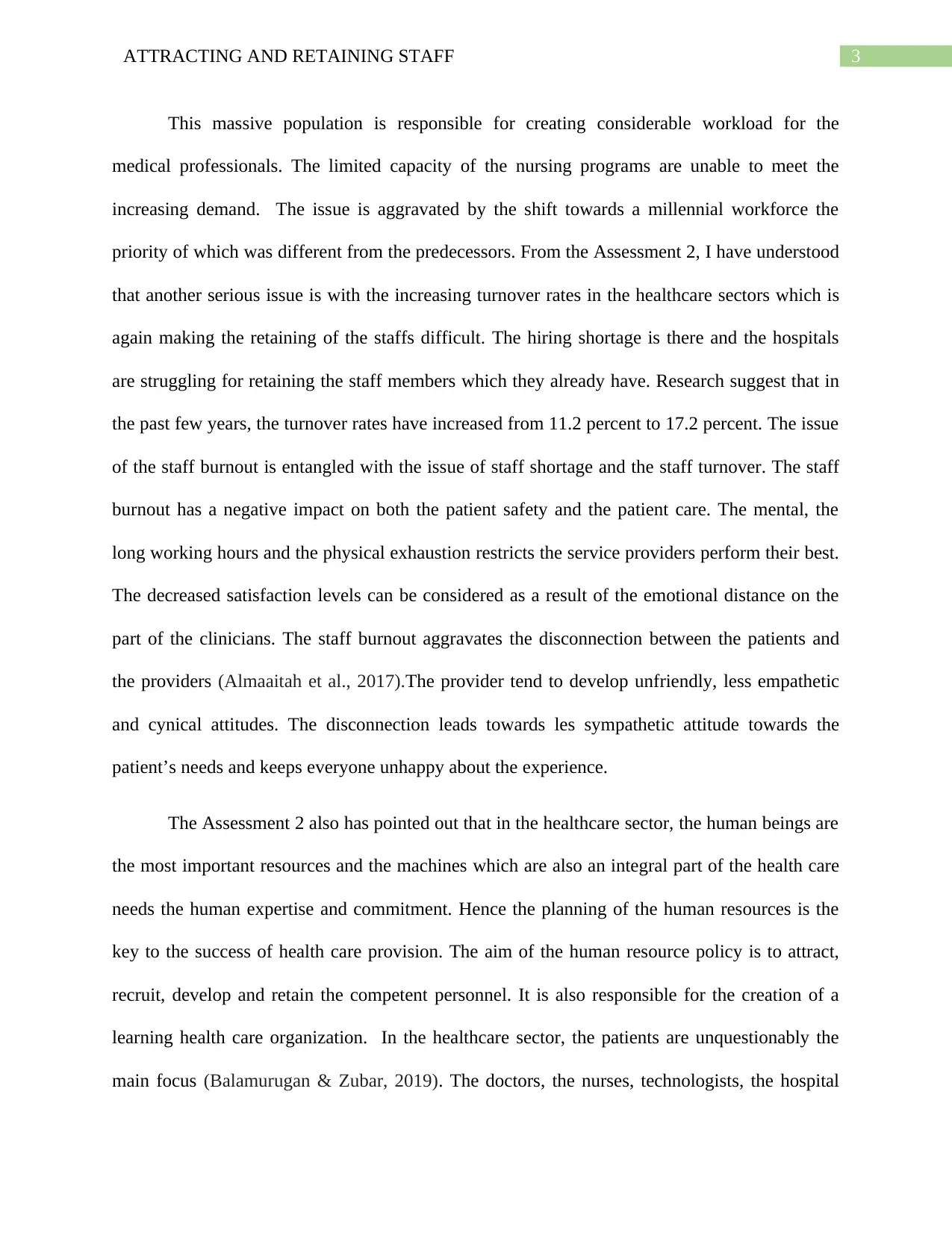
3ATTRACTING AND RETAINING STAFF
This massive population is responsible for creating considerable workload for the
medical professionals. The limited capacity of the nursing programs are unable to meet the
increasing demand. The issue is aggravated by the shift towards a millennial workforce the
priority of which was different from the predecessors. From the Assessment 2, I have understood
that another serious issue is with the increasing turnover rates in the healthcare sectors which is
again making the retaining of the staffs difficult. The hiring shortage is there and the hospitals
are struggling for retaining the staff members which they already have. Research suggest that in
the past few years, the turnover rates have increased from 11.2 percent to 17.2 percent. The issue
of the staff burnout is entangled with the issue of staff shortage and the staff turnover. The staff
burnout has a negative impact on both the patient safety and the patient care. The mental, the
long working hours and the physical exhaustion restricts the service providers perform their best.
The decreased satisfaction levels can be considered as a result of the emotional distance on the
part of the clinicians. The staff burnout aggravates the disconnection between the patients and
the providers (Almaaitah et al., 2017).The provider tend to develop unfriendly, less empathetic
and cynical attitudes. The disconnection leads towards les sympathetic attitude towards the
patient’s needs and keeps everyone unhappy about the experience.
The Assessment 2 also has pointed out that in the healthcare sector, the human beings are
the most important resources and the machines which are also an integral part of the health care
needs the human expertise and commitment. Hence the planning of the human resources is the
key to the success of health care provision. The aim of the human resource policy is to attract,
recruit, develop and retain the competent personnel. It is also responsible for the creation of a
learning health care organization. In the healthcare sector, the patients are unquestionably the
main focus (Balamurugan & Zubar, 2019). The doctors, the nurses, technologists, the hospital
This massive population is responsible for creating considerable workload for the
medical professionals. The limited capacity of the nursing programs are unable to meet the
increasing demand. The issue is aggravated by the shift towards a millennial workforce the
priority of which was different from the predecessors. From the Assessment 2, I have understood
that another serious issue is with the increasing turnover rates in the healthcare sectors which is
again making the retaining of the staffs difficult. The hiring shortage is there and the hospitals
are struggling for retaining the staff members which they already have. Research suggest that in
the past few years, the turnover rates have increased from 11.2 percent to 17.2 percent. The issue
of the staff burnout is entangled with the issue of staff shortage and the staff turnover. The staff
burnout has a negative impact on both the patient safety and the patient care. The mental, the
long working hours and the physical exhaustion restricts the service providers perform their best.
The decreased satisfaction levels can be considered as a result of the emotional distance on the
part of the clinicians. The staff burnout aggravates the disconnection between the patients and
the providers (Almaaitah et al., 2017).The provider tend to develop unfriendly, less empathetic
and cynical attitudes. The disconnection leads towards les sympathetic attitude towards the
patient’s needs and keeps everyone unhappy about the experience.
The Assessment 2 also has pointed out that in the healthcare sector, the human beings are
the most important resources and the machines which are also an integral part of the health care
needs the human expertise and commitment. Hence the planning of the human resources is the
key to the success of health care provision. The aim of the human resource policy is to attract,
recruit, develop and retain the competent personnel. It is also responsible for the creation of a
learning health care organization. In the healthcare sector, the patients are unquestionably the
main focus (Balamurugan & Zubar, 2019). The doctors, the nurses, technologists, the hospital
Paraphrase This Document
Need a fresh take? Get an instant paraphrase of this document with our AI Paraphraser
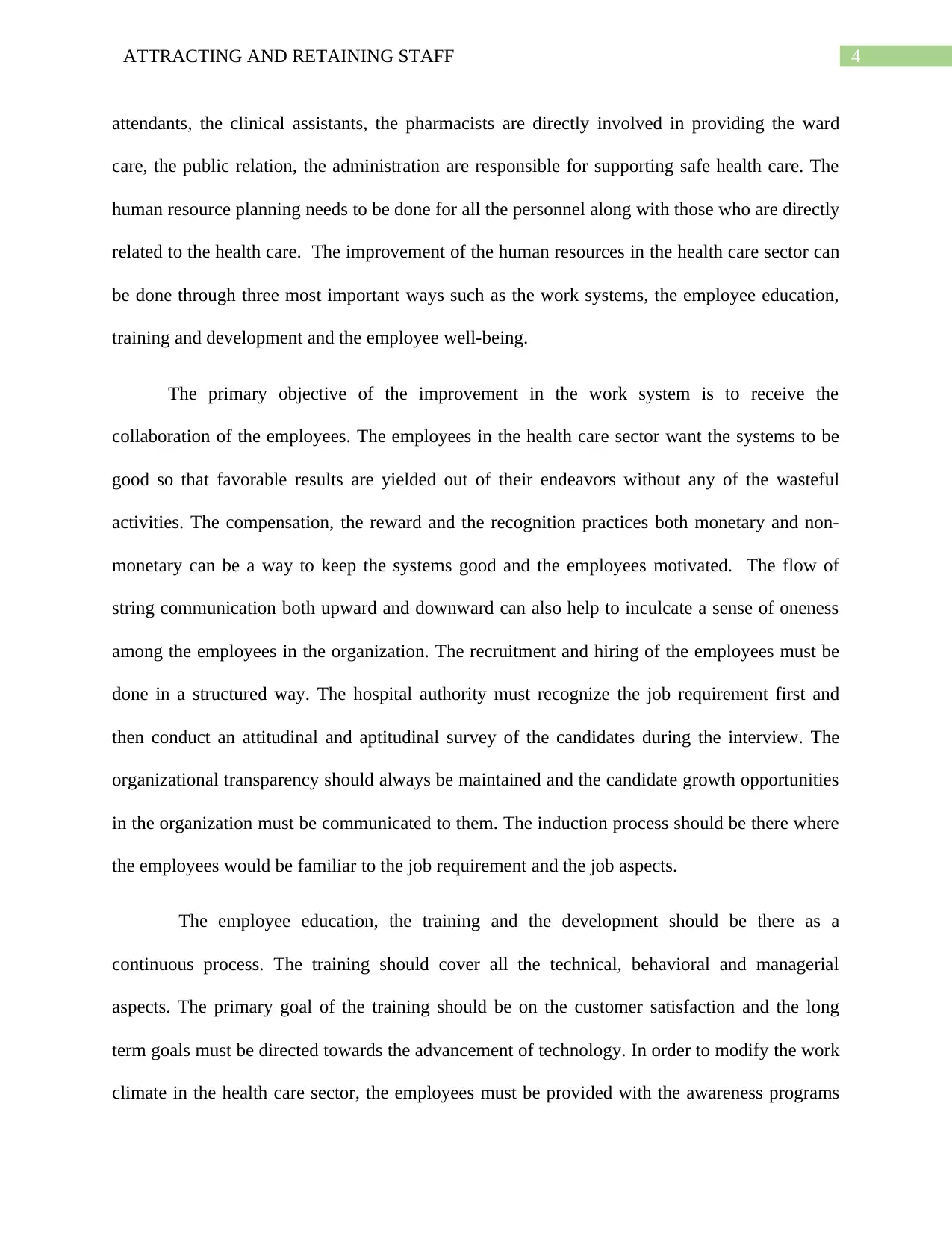
4ATTRACTING AND RETAINING STAFF
attendants, the clinical assistants, the pharmacists are directly involved in providing the ward
care, the public relation, the administration are responsible for supporting safe health care. The
human resource planning needs to be done for all the personnel along with those who are directly
related to the health care. The improvement of the human resources in the health care sector can
be done through three most important ways such as the work systems, the employee education,
training and development and the employee well-being.
The primary objective of the improvement in the work system is to receive the
collaboration of the employees. The employees in the health care sector want the systems to be
good so that favorable results are yielded out of their endeavors without any of the wasteful
activities. The compensation, the reward and the recognition practices both monetary and non-
monetary can be a way to keep the systems good and the employees motivated. The flow of
string communication both upward and downward can also help to inculcate a sense of oneness
among the employees in the organization. The recruitment and hiring of the employees must be
done in a structured way. The hospital authority must recognize the job requirement first and
then conduct an attitudinal and aptitudinal survey of the candidates during the interview. The
organizational transparency should always be maintained and the candidate growth opportunities
in the organization must be communicated to them. The induction process should be there where
the employees would be familiar to the job requirement and the job aspects.
The employee education, the training and the development should be there as a
continuous process. The training should cover all the technical, behavioral and managerial
aspects. The primary goal of the training should be on the customer satisfaction and the long
term goals must be directed towards the advancement of technology. In order to modify the work
climate in the health care sector, the employees must be provided with the awareness programs
attendants, the clinical assistants, the pharmacists are directly involved in providing the ward
care, the public relation, the administration are responsible for supporting safe health care. The
human resource planning needs to be done for all the personnel along with those who are directly
related to the health care. The improvement of the human resources in the health care sector can
be done through three most important ways such as the work systems, the employee education,
training and development and the employee well-being.
The primary objective of the improvement in the work system is to receive the
collaboration of the employees. The employees in the health care sector want the systems to be
good so that favorable results are yielded out of their endeavors without any of the wasteful
activities. The compensation, the reward and the recognition practices both monetary and non-
monetary can be a way to keep the systems good and the employees motivated. The flow of
string communication both upward and downward can also help to inculcate a sense of oneness
among the employees in the organization. The recruitment and hiring of the employees must be
done in a structured way. The hospital authority must recognize the job requirement first and
then conduct an attitudinal and aptitudinal survey of the candidates during the interview. The
organizational transparency should always be maintained and the candidate growth opportunities
in the organization must be communicated to them. The induction process should be there where
the employees would be familiar to the job requirement and the job aspects.
The employee education, the training and the development should be there as a
continuous process. The training should cover all the technical, behavioral and managerial
aspects. The primary goal of the training should be on the customer satisfaction and the long
term goals must be directed towards the advancement of technology. In order to modify the work
climate in the health care sector, the employees must be provided with the awareness programs
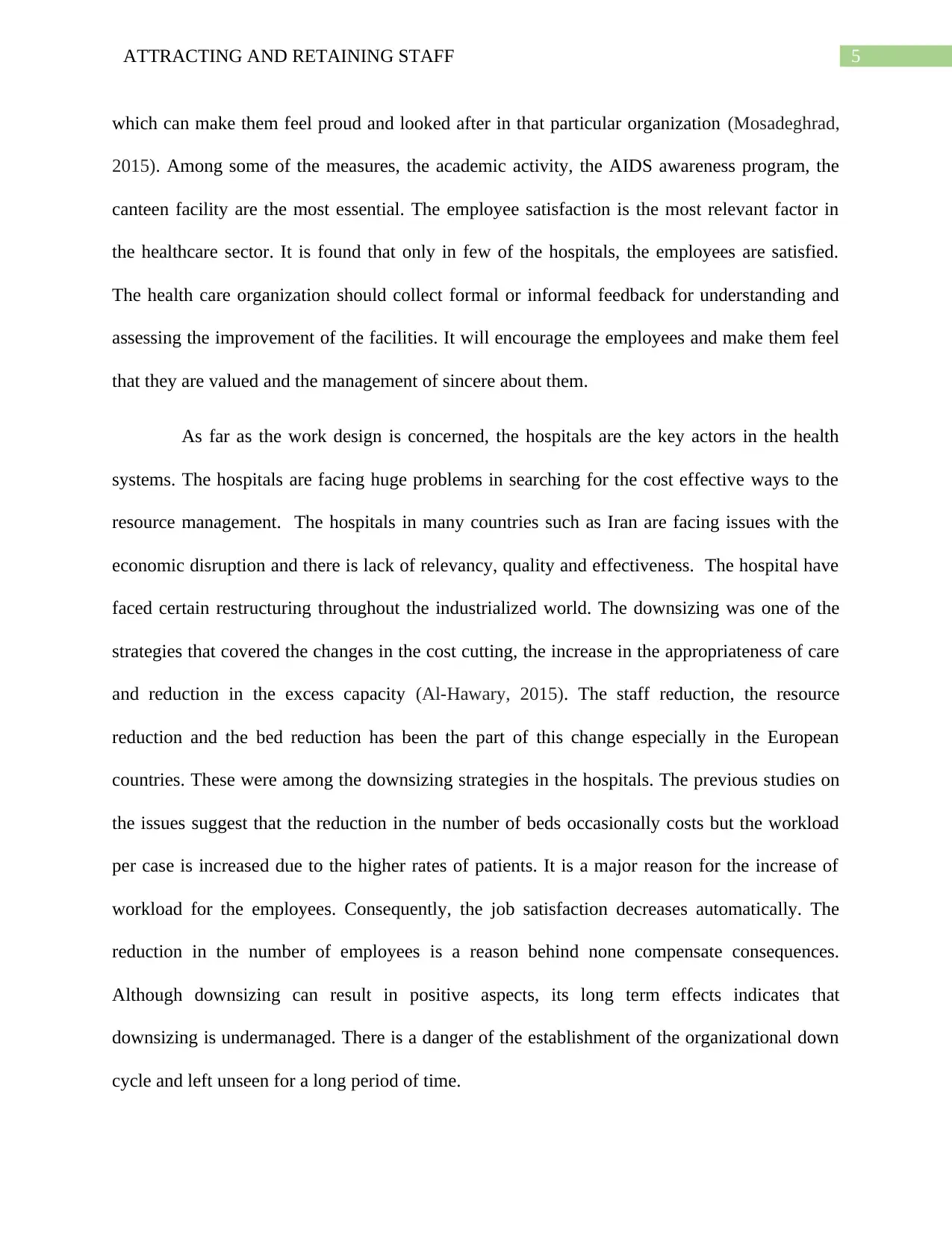
5ATTRACTING AND RETAINING STAFF
which can make them feel proud and looked after in that particular organization (Mosadeghrad,
2015). Among some of the measures, the academic activity, the AIDS awareness program, the
canteen facility are the most essential. The employee satisfaction is the most relevant factor in
the healthcare sector. It is found that only in few of the hospitals, the employees are satisfied.
The health care organization should collect formal or informal feedback for understanding and
assessing the improvement of the facilities. It will encourage the employees and make them feel
that they are valued and the management of sincere about them.
As far as the work design is concerned, the hospitals are the key actors in the health
systems. The hospitals are facing huge problems in searching for the cost effective ways to the
resource management. The hospitals in many countries such as Iran are facing issues with the
economic disruption and there is lack of relevancy, quality and effectiveness. The hospital have
faced certain restructuring throughout the industrialized world. The downsizing was one of the
strategies that covered the changes in the cost cutting, the increase in the appropriateness of care
and reduction in the excess capacity (Al-Hawary, 2015). The staff reduction, the resource
reduction and the bed reduction has been the part of this change especially in the European
countries. These were among the downsizing strategies in the hospitals. The previous studies on
the issues suggest that the reduction in the number of beds occasionally costs but the workload
per case is increased due to the higher rates of patients. It is a major reason for the increase of
workload for the employees. Consequently, the job satisfaction decreases automatically. The
reduction in the number of employees is a reason behind none compensate consequences.
Although downsizing can result in positive aspects, its long term effects indicates that
downsizing is undermanaged. There is a danger of the establishment of the organizational down
cycle and left unseen for a long period of time.
which can make them feel proud and looked after in that particular organization (Mosadeghrad,
2015). Among some of the measures, the academic activity, the AIDS awareness program, the
canteen facility are the most essential. The employee satisfaction is the most relevant factor in
the healthcare sector. It is found that only in few of the hospitals, the employees are satisfied.
The health care organization should collect formal or informal feedback for understanding and
assessing the improvement of the facilities. It will encourage the employees and make them feel
that they are valued and the management of sincere about them.
As far as the work design is concerned, the hospitals are the key actors in the health
systems. The hospitals are facing huge problems in searching for the cost effective ways to the
resource management. The hospitals in many countries such as Iran are facing issues with the
economic disruption and there is lack of relevancy, quality and effectiveness. The hospital have
faced certain restructuring throughout the industrialized world. The downsizing was one of the
strategies that covered the changes in the cost cutting, the increase in the appropriateness of care
and reduction in the excess capacity (Al-Hawary, 2015). The staff reduction, the resource
reduction and the bed reduction has been the part of this change especially in the European
countries. These were among the downsizing strategies in the hospitals. The previous studies on
the issues suggest that the reduction in the number of beds occasionally costs but the workload
per case is increased due to the higher rates of patients. It is a major reason for the increase of
workload for the employees. Consequently, the job satisfaction decreases automatically. The
reduction in the number of employees is a reason behind none compensate consequences.
Although downsizing can result in positive aspects, its long term effects indicates that
downsizing is undermanaged. There is a danger of the establishment of the organizational down
cycle and left unseen for a long period of time.
⊘ This is a preview!⊘
Do you want full access?
Subscribe today to unlock all pages.

Trusted by 1+ million students worldwide
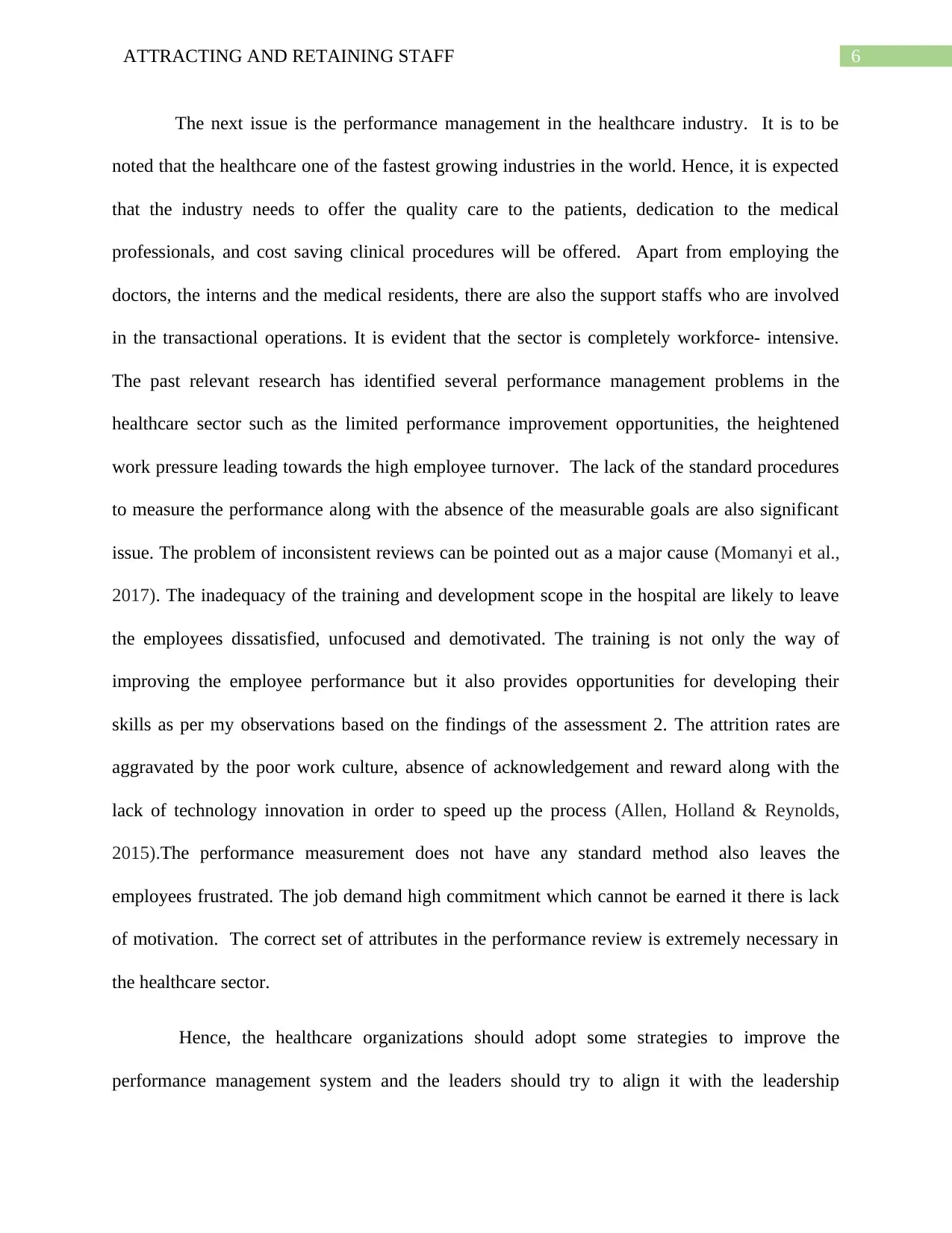
6ATTRACTING AND RETAINING STAFF
The next issue is the performance management in the healthcare industry. It is to be
noted that the healthcare one of the fastest growing industries in the world. Hence, it is expected
that the industry needs to offer the quality care to the patients, dedication to the medical
professionals, and cost saving clinical procedures will be offered. Apart from employing the
doctors, the interns and the medical residents, there are also the support staffs who are involved
in the transactional operations. It is evident that the sector is completely workforce- intensive.
The past relevant research has identified several performance management problems in the
healthcare sector such as the limited performance improvement opportunities, the heightened
work pressure leading towards the high employee turnover. The lack of the standard procedures
to measure the performance along with the absence of the measurable goals are also significant
issue. The problem of inconsistent reviews can be pointed out as a major cause (Momanyi et al.,
2017). The inadequacy of the training and development scope in the hospital are likely to leave
the employees dissatisfied, unfocused and demotivated. The training is not only the way of
improving the employee performance but it also provides opportunities for developing their
skills as per my observations based on the findings of the assessment 2. The attrition rates are
aggravated by the poor work culture, absence of acknowledgement and reward along with the
lack of technology innovation in order to speed up the process (Allen, Holland & Reynolds,
2015).The performance measurement does not have any standard method also leaves the
employees frustrated. The job demand high commitment which cannot be earned it there is lack
of motivation. The correct set of attributes in the performance review is extremely necessary in
the healthcare sector.
Hence, the healthcare organizations should adopt some strategies to improve the
performance management system and the leaders should try to align it with the leadership
The next issue is the performance management in the healthcare industry. It is to be
noted that the healthcare one of the fastest growing industries in the world. Hence, it is expected
that the industry needs to offer the quality care to the patients, dedication to the medical
professionals, and cost saving clinical procedures will be offered. Apart from employing the
doctors, the interns and the medical residents, there are also the support staffs who are involved
in the transactional operations. It is evident that the sector is completely workforce- intensive.
The past relevant research has identified several performance management problems in the
healthcare sector such as the limited performance improvement opportunities, the heightened
work pressure leading towards the high employee turnover. The lack of the standard procedures
to measure the performance along with the absence of the measurable goals are also significant
issue. The problem of inconsistent reviews can be pointed out as a major cause (Momanyi et al.,
2017). The inadequacy of the training and development scope in the hospital are likely to leave
the employees dissatisfied, unfocused and demotivated. The training is not only the way of
improving the employee performance but it also provides opportunities for developing their
skills as per my observations based on the findings of the assessment 2. The attrition rates are
aggravated by the poor work culture, absence of acknowledgement and reward along with the
lack of technology innovation in order to speed up the process (Allen, Holland & Reynolds,
2015).The performance measurement does not have any standard method also leaves the
employees frustrated. The job demand high commitment which cannot be earned it there is lack
of motivation. The correct set of attributes in the performance review is extremely necessary in
the healthcare sector.
Hence, the healthcare organizations should adopt some strategies to improve the
performance management system and the leaders should try to align it with the leadership
Paraphrase This Document
Need a fresh take? Get an instant paraphrase of this document with our AI Paraphraser
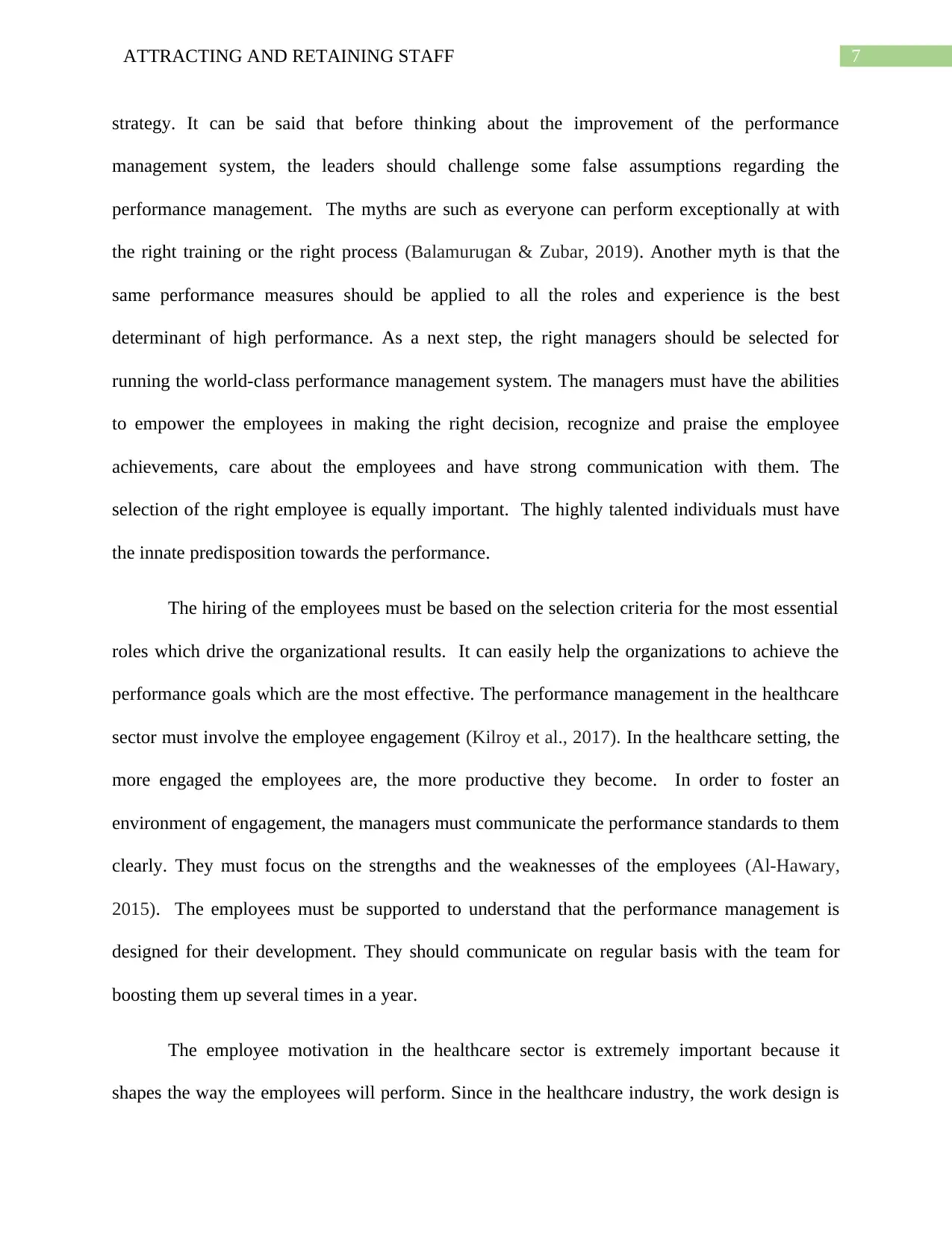
7ATTRACTING AND RETAINING STAFF
strategy. It can be said that before thinking about the improvement of the performance
management system, the leaders should challenge some false assumptions regarding the
performance management. The myths are such as everyone can perform exceptionally at with
the right training or the right process (Balamurugan & Zubar, 2019). Another myth is that the
same performance measures should be applied to all the roles and experience is the best
determinant of high performance. As a next step, the right managers should be selected for
running the world-class performance management system. The managers must have the abilities
to empower the employees in making the right decision, recognize and praise the employee
achievements, care about the employees and have strong communication with them. The
selection of the right employee is equally important. The highly talented individuals must have
the innate predisposition towards the performance.
The hiring of the employees must be based on the selection criteria for the most essential
roles which drive the organizational results. It can easily help the organizations to achieve the
performance goals which are the most effective. The performance management in the healthcare
sector must involve the employee engagement (Kilroy et al., 2017). In the healthcare setting, the
more engaged the employees are, the more productive they become. In order to foster an
environment of engagement, the managers must communicate the performance standards to them
clearly. They must focus on the strengths and the weaknesses of the employees (Al-Hawary,
2015). The employees must be supported to understand that the performance management is
designed for their development. They should communicate on regular basis with the team for
boosting them up several times in a year.
The employee motivation in the healthcare sector is extremely important because it
shapes the way the employees will perform. Since in the healthcare industry, the work design is
strategy. It can be said that before thinking about the improvement of the performance
management system, the leaders should challenge some false assumptions regarding the
performance management. The myths are such as everyone can perform exceptionally at with
the right training or the right process (Balamurugan & Zubar, 2019). Another myth is that the
same performance measures should be applied to all the roles and experience is the best
determinant of high performance. As a next step, the right managers should be selected for
running the world-class performance management system. The managers must have the abilities
to empower the employees in making the right decision, recognize and praise the employee
achievements, care about the employees and have strong communication with them. The
selection of the right employee is equally important. The highly talented individuals must have
the innate predisposition towards the performance.
The hiring of the employees must be based on the selection criteria for the most essential
roles which drive the organizational results. It can easily help the organizations to achieve the
performance goals which are the most effective. The performance management in the healthcare
sector must involve the employee engagement (Kilroy et al., 2017). In the healthcare setting, the
more engaged the employees are, the more productive they become. In order to foster an
environment of engagement, the managers must communicate the performance standards to them
clearly. They must focus on the strengths and the weaknesses of the employees (Al-Hawary,
2015). The employees must be supported to understand that the performance management is
designed for their development. They should communicate on regular basis with the team for
boosting them up several times in a year.
The employee motivation in the healthcare sector is extremely important because it
shapes the way the employees will perform. Since in the healthcare industry, the work design is
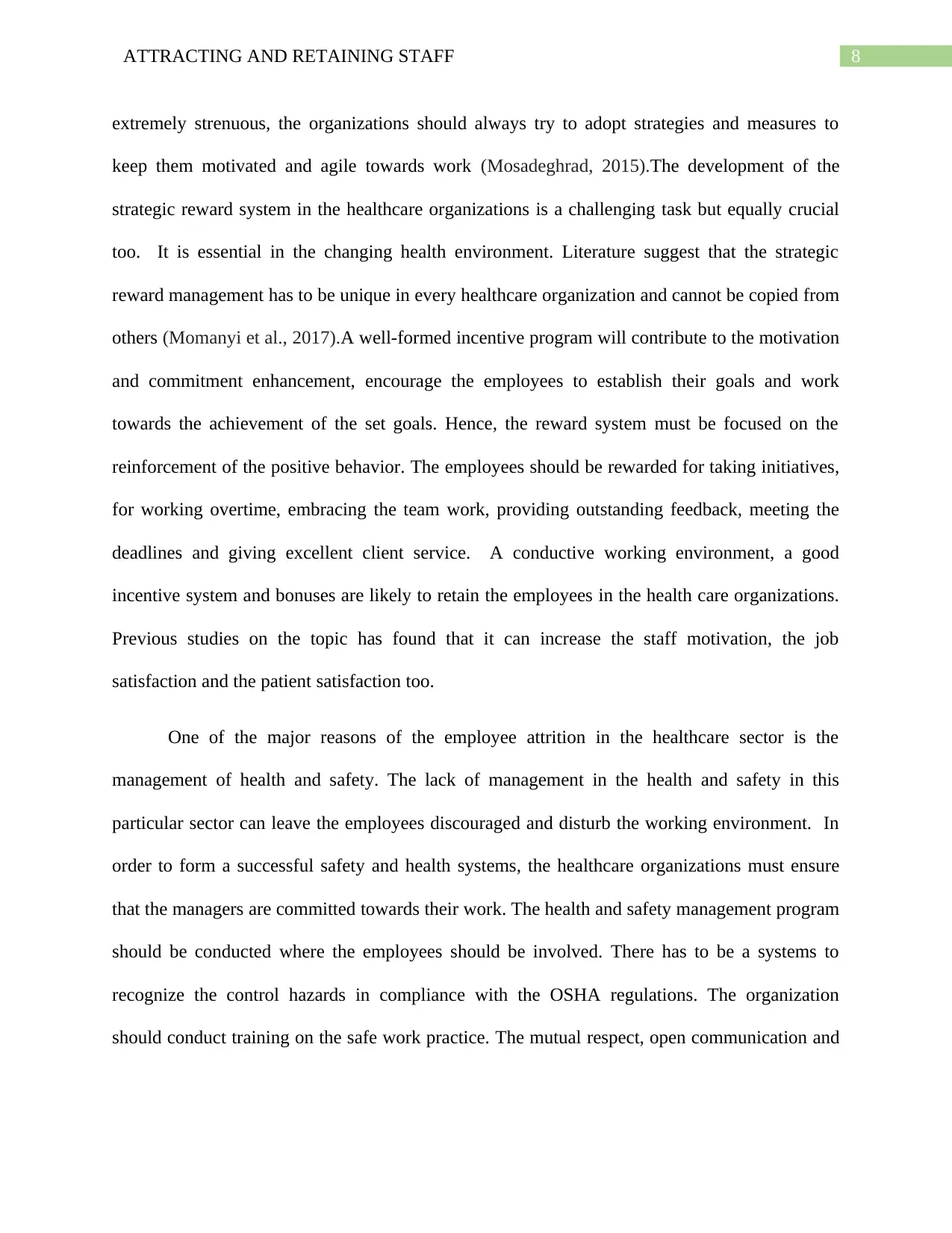
8ATTRACTING AND RETAINING STAFF
extremely strenuous, the organizations should always try to adopt strategies and measures to
keep them motivated and agile towards work (Mosadeghrad, 2015).The development of the
strategic reward system in the healthcare organizations is a challenging task but equally crucial
too. It is essential in the changing health environment. Literature suggest that the strategic
reward management has to be unique in every healthcare organization and cannot be copied from
others (Momanyi et al., 2017).A well-formed incentive program will contribute to the motivation
and commitment enhancement, encourage the employees to establish their goals and work
towards the achievement of the set goals. Hence, the reward system must be focused on the
reinforcement of the positive behavior. The employees should be rewarded for taking initiatives,
for working overtime, embracing the team work, providing outstanding feedback, meeting the
deadlines and giving excellent client service. A conductive working environment, a good
incentive system and bonuses are likely to retain the employees in the health care organizations.
Previous studies on the topic has found that it can increase the staff motivation, the job
satisfaction and the patient satisfaction too.
One of the major reasons of the employee attrition in the healthcare sector is the
management of health and safety. The lack of management in the health and safety in this
particular sector can leave the employees discouraged and disturb the working environment. In
order to form a successful safety and health systems, the healthcare organizations must ensure
that the managers are committed towards their work. The health and safety management program
should be conducted where the employees should be involved. There has to be a systems to
recognize the control hazards in compliance with the OSHA regulations. The organization
should conduct training on the safe work practice. The mutual respect, open communication and
extremely strenuous, the organizations should always try to adopt strategies and measures to
keep them motivated and agile towards work (Mosadeghrad, 2015).The development of the
strategic reward system in the healthcare organizations is a challenging task but equally crucial
too. It is essential in the changing health environment. Literature suggest that the strategic
reward management has to be unique in every healthcare organization and cannot be copied from
others (Momanyi et al., 2017).A well-formed incentive program will contribute to the motivation
and commitment enhancement, encourage the employees to establish their goals and work
towards the achievement of the set goals. Hence, the reward system must be focused on the
reinforcement of the positive behavior. The employees should be rewarded for taking initiatives,
for working overtime, embracing the team work, providing outstanding feedback, meeting the
deadlines and giving excellent client service. A conductive working environment, a good
incentive system and bonuses are likely to retain the employees in the health care organizations.
Previous studies on the topic has found that it can increase the staff motivation, the job
satisfaction and the patient satisfaction too.
One of the major reasons of the employee attrition in the healthcare sector is the
management of health and safety. The lack of management in the health and safety in this
particular sector can leave the employees discouraged and disturb the working environment. In
order to form a successful safety and health systems, the healthcare organizations must ensure
that the managers are committed towards their work. The health and safety management program
should be conducted where the employees should be involved. There has to be a systems to
recognize the control hazards in compliance with the OSHA regulations. The organization
should conduct training on the safe work practice. The mutual respect, open communication and
⊘ This is a preview!⊘
Do you want full access?
Subscribe today to unlock all pages.

Trusted by 1+ million students worldwide
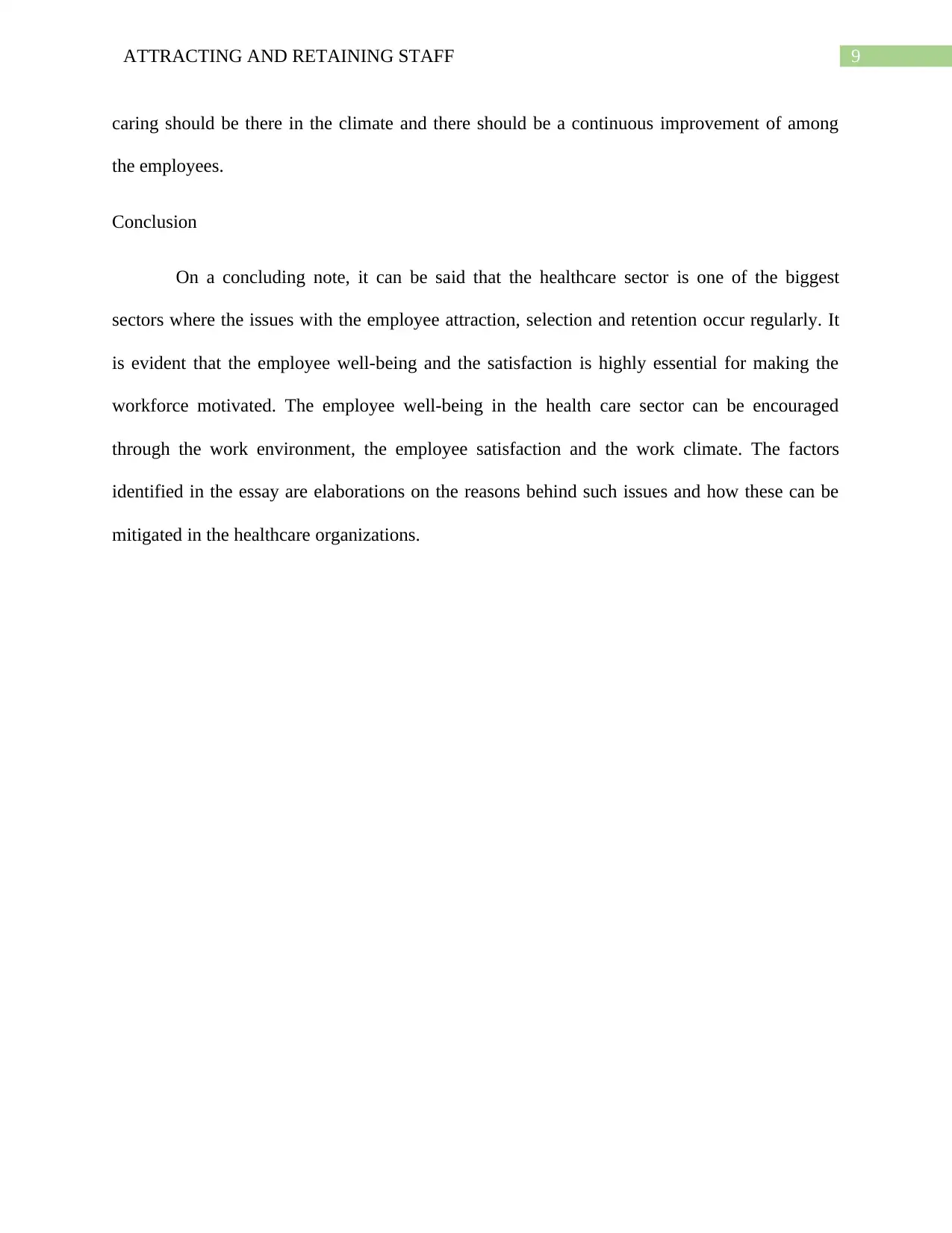
9ATTRACTING AND RETAINING STAFF
caring should be there in the climate and there should be a continuous improvement of among
the employees.
Conclusion
On a concluding note, it can be said that the healthcare sector is one of the biggest
sectors where the issues with the employee attraction, selection and retention occur regularly. It
is evident that the employee well-being and the satisfaction is highly essential for making the
workforce motivated. The employee well-being in the health care sector can be encouraged
through the work environment, the employee satisfaction and the work climate. The factors
identified in the essay are elaborations on the reasons behind such issues and how these can be
mitigated in the healthcare organizations.
caring should be there in the climate and there should be a continuous improvement of among
the employees.
Conclusion
On a concluding note, it can be said that the healthcare sector is one of the biggest
sectors where the issues with the employee attraction, selection and retention occur regularly. It
is evident that the employee well-being and the satisfaction is highly essential for making the
workforce motivated. The employee well-being in the health care sector can be encouraged
through the work environment, the employee satisfaction and the work climate. The factors
identified in the essay are elaborations on the reasons behind such issues and how these can be
mitigated in the healthcare organizations.
Paraphrase This Document
Need a fresh take? Get an instant paraphrase of this document with our AI Paraphraser
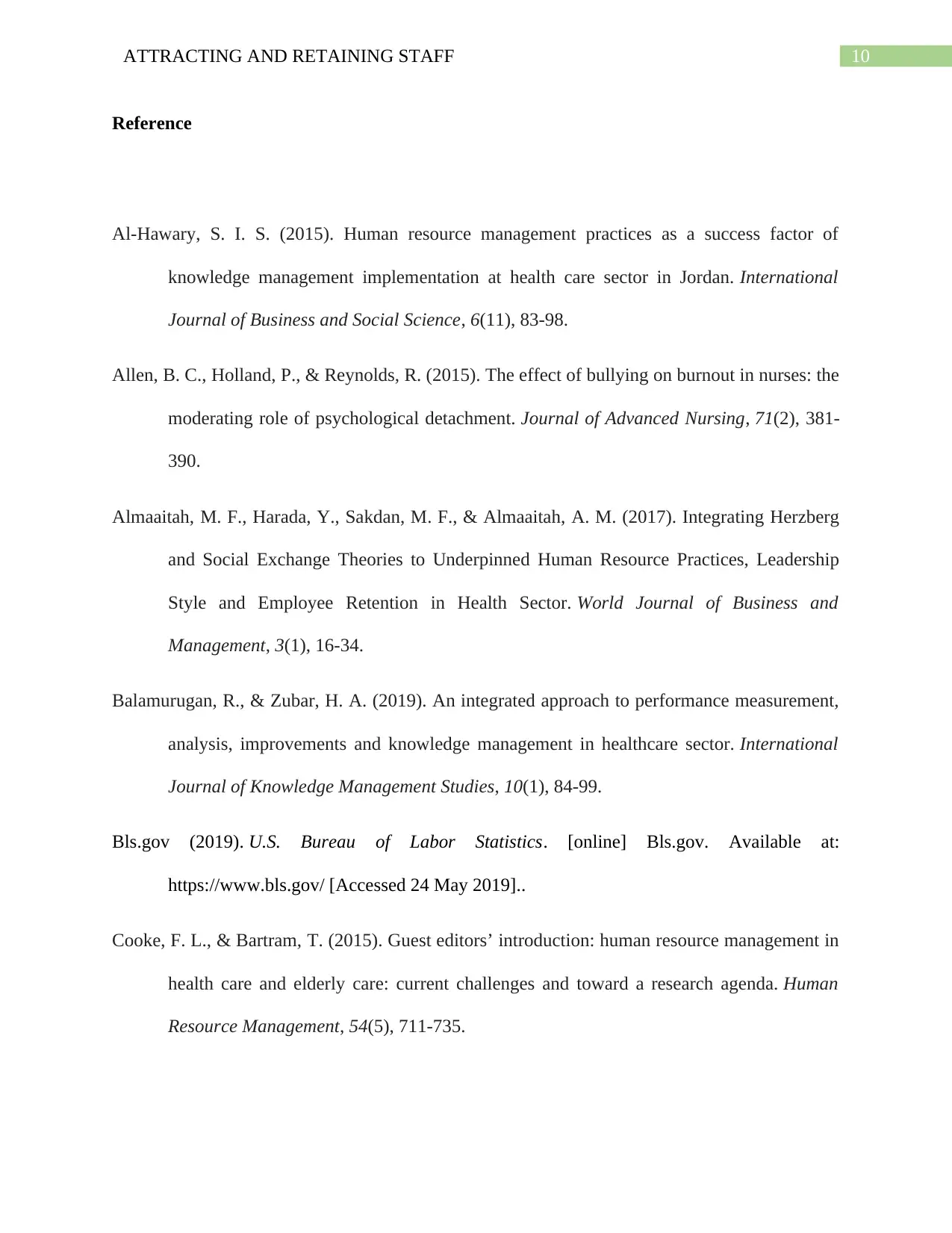
10ATTRACTING AND RETAINING STAFF
Reference
Al-Hawary, S. I. S. (2015). Human resource management practices as a success factor of
knowledge management implementation at health care sector in Jordan. International
Journal of Business and Social Science, 6(11), 83-98.
Allen, B. C., Holland, P., & Reynolds, R. (2015). The effect of bullying on burnout in nurses: the
moderating role of psychological detachment. Journal of Advanced Nursing, 71(2), 381-
390.
Almaaitah, M. F., Harada, Y., Sakdan, M. F., & Almaaitah, A. M. (2017). Integrating Herzberg
and Social Exchange Theories to Underpinned Human Resource Practices, Leadership
Style and Employee Retention in Health Sector. World Journal of Business and
Management, 3(1), 16-34.
Balamurugan, R., & Zubar, H. A. (2019). An integrated approach to performance measurement,
analysis, improvements and knowledge management in healthcare sector. International
Journal of Knowledge Management Studies, 10(1), 84-99.
Bls.gov (2019). U.S. Bureau of Labor Statistics. [online] Bls.gov. Available at:
https://www.bls.gov/ [Accessed 24 May 2019]..
Cooke, F. L., & Bartram, T. (2015). Guest editors’ introduction: human resource management in
health care and elderly care: current challenges and toward a research agenda. Human
Resource Management, 54(5), 711-735.
Reference
Al-Hawary, S. I. S. (2015). Human resource management practices as a success factor of
knowledge management implementation at health care sector in Jordan. International
Journal of Business and Social Science, 6(11), 83-98.
Allen, B. C., Holland, P., & Reynolds, R. (2015). The effect of bullying on burnout in nurses: the
moderating role of psychological detachment. Journal of Advanced Nursing, 71(2), 381-
390.
Almaaitah, M. F., Harada, Y., Sakdan, M. F., & Almaaitah, A. M. (2017). Integrating Herzberg
and Social Exchange Theories to Underpinned Human Resource Practices, Leadership
Style and Employee Retention in Health Sector. World Journal of Business and
Management, 3(1), 16-34.
Balamurugan, R., & Zubar, H. A. (2019). An integrated approach to performance measurement,
analysis, improvements and knowledge management in healthcare sector. International
Journal of Knowledge Management Studies, 10(1), 84-99.
Bls.gov (2019). U.S. Bureau of Labor Statistics. [online] Bls.gov. Available at:
https://www.bls.gov/ [Accessed 24 May 2019]..
Cooke, F. L., & Bartram, T. (2015). Guest editors’ introduction: human resource management in
health care and elderly care: current challenges and toward a research agenda. Human
Resource Management, 54(5), 711-735.
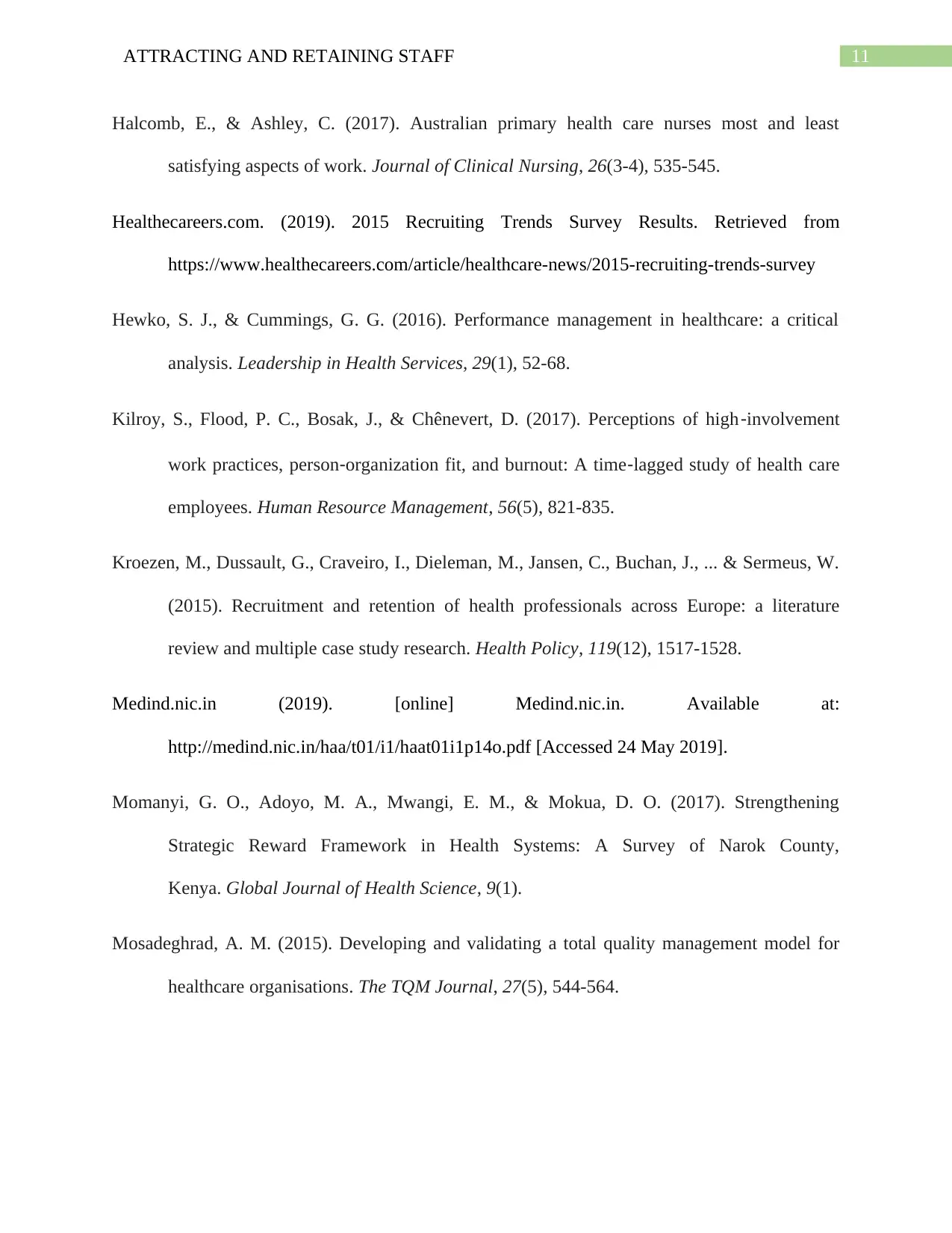
11ATTRACTING AND RETAINING STAFF
Halcomb, E., & Ashley, C. (2017). Australian primary health care nurses most and least
satisfying aspects of work. Journal of Clinical Nursing, 26(3-4), 535-545.
Healthecareers.com. (2019). 2015 Recruiting Trends Survey Results. Retrieved from
https://www.healthecareers.com/article/healthcare-news/2015-recruiting-trends-survey
Hewko, S. J., & Cummings, G. G. (2016). Performance management in healthcare: a critical
analysis. Leadership in Health Services, 29(1), 52-68.
Kilroy, S., Flood, P. C., Bosak, J., & Chênevert, D. (2017). Perceptions of high‐involvement
work practices, person‐organization fit, and burnout: A time‐lagged study of health care
employees. Human Resource Management, 56(5), 821-835.
Kroezen, M., Dussault, G., Craveiro, I., Dieleman, M., Jansen, C., Buchan, J., ... & Sermeus, W.
(2015). Recruitment and retention of health professionals across Europe: a literature
review and multiple case study research. Health Policy, 119(12), 1517-1528.
Medind.nic.in (2019). [online] Medind.nic.in. Available at:
http://medind.nic.in/haa/t01/i1/haat01i1p14o.pdf [Accessed 24 May 2019].
Momanyi, G. O., Adoyo, M. A., Mwangi, E. M., & Mokua, D. O. (2017). Strengthening
Strategic Reward Framework in Health Systems: A Survey of Narok County,
Kenya. Global Journal of Health Science, 9(1).
Mosadeghrad, A. M. (2015). Developing and validating a total quality management model for
healthcare organisations. The TQM Journal, 27(5), 544-564.
Halcomb, E., & Ashley, C. (2017). Australian primary health care nurses most and least
satisfying aspects of work. Journal of Clinical Nursing, 26(3-4), 535-545.
Healthecareers.com. (2019). 2015 Recruiting Trends Survey Results. Retrieved from
https://www.healthecareers.com/article/healthcare-news/2015-recruiting-trends-survey
Hewko, S. J., & Cummings, G. G. (2016). Performance management in healthcare: a critical
analysis. Leadership in Health Services, 29(1), 52-68.
Kilroy, S., Flood, P. C., Bosak, J., & Chênevert, D. (2017). Perceptions of high‐involvement
work practices, person‐organization fit, and burnout: A time‐lagged study of health care
employees. Human Resource Management, 56(5), 821-835.
Kroezen, M., Dussault, G., Craveiro, I., Dieleman, M., Jansen, C., Buchan, J., ... & Sermeus, W.
(2015). Recruitment and retention of health professionals across Europe: a literature
review and multiple case study research. Health Policy, 119(12), 1517-1528.
Medind.nic.in (2019). [online] Medind.nic.in. Available at:
http://medind.nic.in/haa/t01/i1/haat01i1p14o.pdf [Accessed 24 May 2019].
Momanyi, G. O., Adoyo, M. A., Mwangi, E. M., & Mokua, D. O. (2017). Strengthening
Strategic Reward Framework in Health Systems: A Survey of Narok County,
Kenya. Global Journal of Health Science, 9(1).
Mosadeghrad, A. M. (2015). Developing and validating a total quality management model for
healthcare organisations. The TQM Journal, 27(5), 544-564.
⊘ This is a preview!⊘
Do you want full access?
Subscribe today to unlock all pages.

Trusted by 1+ million students worldwide
1 out of 12
Related Documents
Your All-in-One AI-Powered Toolkit for Academic Success.
+13062052269
info@desklib.com
Available 24*7 on WhatsApp / Email
![[object Object]](/_next/static/media/star-bottom.7253800d.svg)
Unlock your academic potential
Copyright © 2020–2025 A2Z Services. All Rights Reserved. Developed and managed by ZUCOL.



